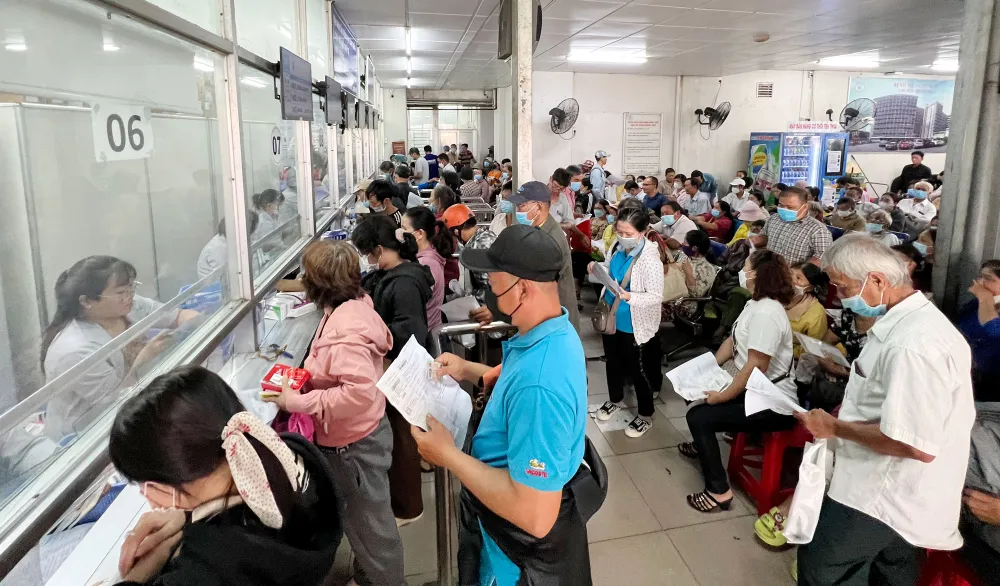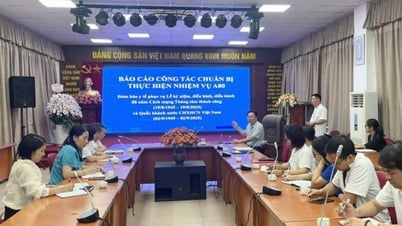Eliminate the worry of waiting
Every month, Ms. Nguyen Thi Hien (62 years old, living in Bay Hien ward, Ho Chi Minh City) walks 1.4 km to Thong Nhat Hospital to queue up to get a prescription. “Every 21 days, I have to go at 5 am to get a check-up. It is called a check-up but in reality, there is not much to check, and the tests are not done regularly, only once every 3-6 months. The doctor asks about the patient's condition, and if there is nothing unusual, he prescribes the medicine as usual,” Ms. Hien shared. Now that the prescription period has been “extended” to 90 days, Ms. Hien no longer has to go to the hospital every month.
Mr. Nguyen Van Ut (63 years old, living in Ben Thanh ward, Ho Chi Minh City) was also excited to know that diabetes is on the list of chronic diseases that are given medicine for more than 30 days, helping him avoid having to go back and forth to the hospital.
According to Circular 26, some chronic diseases will be prescribed outpatient drugs for use for more than 30 days, up to 90 days, instead of only being given drugs for a maximum of 30 days as before. The list includes 16 major disease groups, with 252 diseases and chronic disease groups, such as: hypertension, diabetes, chronic obstructive pulmonary disease (COPD), bronchial asthma, chronic hepatitis B, HIV/AIDS, Parkinson's, Alzheimer's, depression, anxiety disorders, congenital hemolytic anemia (Thalassemia), hypothyroidism, pituitary failure, dementia, breast cancer, thyroid cancer...

Dr. Mai Duc Huy, Deputy Director of Saigon General Hospital, analyzed that extending the time to dispense medicine for people with chronic diseases helps reduce the psychological pressure of going to the doctor every month, reduces the inconvenience for patients, and reduces the burden on the hospital. However, doctors must carefully consider when prescribing medicine for patients for up to 60 days or 90 days, because it depends on whether the patient's health is stable or not to have a flexible assessment. For the elderly, the disease progression is very easy to become severe, so when prescribing medicine, it must be based on the patient's health condition.
Lower level hospitals, remote areas face difficulties
According to the Ministry of Health , in the initial period of applying Circular 26, some grassroots medical facilities, especially in remote areas, may face challenges in ensuring adequate drug supply when the number of drugs prescribed each time increases three times compared to before. In addition, some specialized drugs may not be popular or may be in short supply locally at certain times.
In the coming time, the Ministry of Health will continue to issue specific professional guidelines to support localities in upgrading prescription management software, improving prescription procedures, and synchronizing monitoring systems to monitor implementation effectiveness. The Ministry of Health encourages units to proactively review and estimate reasonable drug stocks based on actual prescriptions, to ensure that patients are fully dispensed and not interrupted in treatment.
Tighten prescription
Explaining the regulation on extending the prescription period to a maximum of 90 days instead of 1 month as before, Dr. Vuong Anh Duong, Deputy Director of the Department of Medical Examination and Treatment Management (Ministry of Health), said that having to go to the hospital every month to get a prescription, even though the disease has stabilized, really causes a lot of inconvenience and a significant burden for the patient and their family. For those who live far from the hospital, the cost of travel can sometimes be higher than the cost of medicine. However, according to Dr. Vuong Anh Duong, prescribing medicine must comply with technical regulations; prescribe medicine when it is really necessary, for the right purpose, safely, reasonably and effectively; the prescription must be consistent with the diagnosis.
In Circular No. 26, the Ministry of Health requires medical examination and treatment facilities organized as hospitals to implement electronic prescriptions before October 1; all other medical examination and treatment facilities must also implement them from January 1, 2026. Electronic prescriptions are part of electronic medical records. The Ministry of Health requires medical examination and treatment facilities to be responsible for sending electronic prescriptions to the national prescription system immediately after completing the examination and treatment process for outpatients or inpatients. At that time, the prescription and drug sales systems will be connected. Patients who buy drugs will be controlled according to the prescriptions in the system. Which prescriptions are sold, which drugs are sold differently from the prescription can all be tracked. This is a huge step forward in controlling the sale of drugs without a prescription, especially antibiotics.
Do not allow the exploitation of regulations to increase drug prices.
The Ministry of Health has just issued an official dispatch on rectifying the procurement, bidding of drugs, medical equipment, and advances for health insurance examination and treatment costs. Accordingly, in order to prevent and stop violations of the law on health insurance, and to prevent fraud and profiteering from the health insurance fund, the Ministry of Health requests heads of health units to review and strictly implement the contents in accordance with regulations. In particular, regarding the procurement and supply of drugs and medical equipment, the Ministry of Health requires units to strictly implement the regulations on procurement and bidding, ensuring publicity and transparency, and not allowing the situation of taking advantage of regulations to increase drug prices, especially for herbal medicines and traditional medicines.
MINH KHANG
Source: https://www.sggp.org.vn/noi-thoi-gian-ke-don-thuoc-benh-man-tinh-giam-tai-benh-vien-bot-phien-ha-cho-benh-nhan-post802726.html



![[Photo] Prime Minister Pham Minh Chinh meets with Speaker of the New Zealand Parliament Gerry Brownlee](https://vphoto.vietnam.vn/thumb/1200x675/vietnam/resource/IMAGE/2025/8/28/cec2630220ec49efbb04030e664995db)
![[Photo] Red flag with yellow star flutters in France on National Day September 2](https://vphoto.vietnam.vn/thumb/1200x675/vietnam/resource/IMAGE/2025/8/28/f6fc12215220488bb859230b86b9cc12)
![[Photo] General Secretary To Lam attends the opening ceremony of the National Achievements Exhibition](https://vphoto.vietnam.vn/thumb/1200x675/vietnam/resource/IMAGE/2025/8/28/d371751d37634474bb3d91c6f701be7f)
![[Photo] Politburo works with the Standing Committee of Cao Bang Provincial Party Committee and Hue City Party Committee](https://vphoto.vietnam.vn/thumb/1200x675/vietnam/resource/IMAGE/2025/8/28/fee8a847b1ff45188749eb0299c512b2)

![[Photo] General Secretary To Lam presents the 45-year Party membership badge to comrade Phan Dinh Trac](https://vphoto.vietnam.vn/thumb/1200x675/vietnam/resource/IMAGE/2025/8/28/e2f08c400e504e38ac694bc6142ac331)































































































Comment (0)